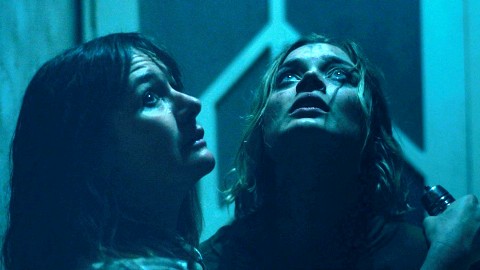 Getting old is the source of fear in a new horror movie by Natalie Erika James, about a woman on the edge of dementia whose daughter and granddaughter visit, trying to help.
Getting old is the source of fear in a new horror movie by Natalie Erika James, about a woman on the edge of dementia whose daughter and granddaughter visit, trying to help.
Filmmakers are still finding new themes and methods to incorporate into horror movies. Despite the genre’s persistent image as unserious and even trashy, there have always been artists expressing truths about human beings and their society through the lens of horror.
A recent example is Relic, the first feature by Australian writer-director Natalie Erika James. It premiered at the Sundance Film Festival last year, and it has done fairly well since, although I think it ended up going under the radar like everything else during the pandemic, which shut down movie theaters worldwide. But it’s now available streaming, and on DVD and Blu-ray, and it’s well worth your time. For me, it succeeds because of little things—James and her co-screenwriter Christian White know that it’s not the big obvious scares that make a horror movie work, but the small details and subtle touches that best play on our fears.
Emily Mortimer plays Kay, a single mother in her forties whose adult daughter Sam still lives with her. One day Kay gets a call from the police that her elderly mother Edna, who is in her eighties and lives in a rural area on the outskirts of Melbourne, has not been seen for several days. Fearing the worst, she goes with Sam to her mother’s house. There’s no sign of Edna, and the house is in a bad state. One of the disturbing things is creeping mold everywhere, which element effectively conveys a sense of dread and disgust. It feels like there’s something awful hidden out of sight, perhaps in the walls.
Kay and Sam set to work cleaning the house as best they can. After a few days, Edna suddenly shows up, but she seems completely disoriented and has no idea where she’s been. A doctor checks her out and finds nothing physically wrong with her, but the behavior indicates possible dementia. It quickly becomes clear that Kay has a broken relationship with her mother, that events in the past have caused some sort of an estrangement. Now Edna alternates between fearful confusion and surprising outbursts of rage and viciousness. Her granddaughter, Sam, is more sympathetic and even offers to move there for awhile to take care of Edna, but Kay doesn’t want that.
Over the next few days, a time conveyed by the director in slow and unnerving tracking shots throughout the house, a feeling that Edna’s home is possessed by something, and who knows what, becomes more pronounced, and all three women struggle with this gradually increasing fear in different ways.
The grandmother, Edna, is played by Robyn Nevin, a name most Americans aren’t aware of, although she did have a part in the two Matrix sequels. In fact, she’s one of Australia’s most famous actresses, especially in theater, where she’s excelled as a performer, director and producer. Her work in this film is impeccable—she seems to have actually become this tormented old woman, the focal point of the story’s mystery and dread. It’s not that Edna is particularly scary, but her experience of dementia strongly affects, and you might even say infects, the two other women in the story. Kay is always trying desperately to keep her head afloat in the midst of creeping panic. And Emily Mortimer is very good at playing these tense, high-strung neurotic types. The young Bella Heathcote holds her own as the emotional and vulnerable granddaughter, Sam.
Yes, the film is about something. It’s tempting to try to explain it in this review, but explanations give too much away, and besides, they’re too simplistic. The meaning here is not at all simple—extreme loneliness and paranoia play a part as well as the universal themes of old age and death. The horror is both understated and intense in this movie, and the director brilliantly constructs the horror experience so that it contains a lot of different fascinating themes, feelings, and ideas. The mystery of Relic does finally reveal itself, and it feels a little like the shock of waking up suddenly, looking around and thinking, “Where am I?”

One of the gems among Alfred Hitchcock’s early British films, Sabotage tells of an enemy agent in 1930s England, and the tragic consequences of...

Catherine Deneuve plays a famous actress in conflict with her daughter, played by Juliette Binoche, in Hirokazu Kore-eda’s first film made outside of Japan....

Minari, the latest film from writer-director Lee Isaac Chung, tells the story of an immigrant Korean family’s struggle to make a new life in...